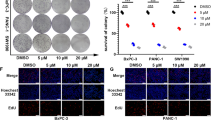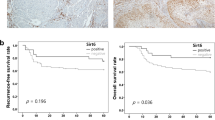Abstract
N-(4-hydroxyphenyl)retinamide (4HPR), a synthetic retinoid effective in cancer chemoprevention and therapy, is thought to act via apoptosis induction resulting from increased reactive oxygen species (ROS) generation. As ROS can activate MAP kinases and protein kinase C (PKC), we examined the role of such enzymes in 4HPR-induced apoptosis in HNSCC UMSCC22B cells. 4HPR increased ROS level within 1 h and induced activation of caspase 3 and PARP cleavage within 24 h. Activation of MKK3/6 and MKK4, JNK, p38 and ERK was detected between 6 and 12 h, increased up to 24 h and preceded apoptosis. 4HPR-induced activation of these kinases was abrogated by the antioxidants BHA and vitamin C. SP600125, a JNK inhibitor, suppressed 4HPR-induced c-Jun phosphorylation, cytochrome c release from mitochondria and apoptosis. Suppression of JNK1 and JNK2 using siRNA decreased, whereas overexpression of wild type-JNK1 enhanced 4HPR-induced apoptosis. PD169316, a p38, inhibitor suppressed phosphorylation of Hsp27 and apoptosis. PD98059, an MEK1/2 inhibitor, also suppressed ERK1/2 activation and apoptosis induced by 4HPR. Likewise, PKC inhibitor GF109203X suppressed ERK and p38 phosphorylation and PARP cleavage. These data indicate that 4HPR-induced apoptosis is triggered by ROS increase, leading to the activation of the mitogen-activated protein serine/threonine kinases JNK, p38, PKC and ERK, and subsequent apoptosis.
This is a preview of subscription content, access via your institution
Access options
Subscribe to this journal
Receive 50 print issues and online access
$259.00 per year
only $5.18 per issue
Buy this article
- Purchase on Springer Link
- Instant access to full article PDF
Prices may be subject to local taxes which are calculated during checkout









Similar content being viewed by others
References
Aikawa R, Komuro I, Yamazaki T, Zou Y, Kudoh S, Tanaka M et al. (1997). J Clin Invest 100: 1813–1821.
Asumendi A, Morales MC, Alvarez A, Arechaga J, Perez-Yarza G . (2002). Br J Cancer 86: 1951–1956.
Bennett BL, Sasaki DT, Murray BW, O'Leary EC, Sakata ST, Xu W et al. (2001). Proc Natl Acad Sci USA 98: 13681–13686.
Bhatt NY, Kelley TW, Khramtsov VV, Wang Y, Lam GK, Clanton TL et al. (2002). J Immunol 169: 6427–6434.
Boya P, Morales MC, Gonzalez-Polo RA, Andreau K, Gourdier I, Perfettini JL et al. (2003). Oncogene 22: 6220–6230.
Carvalho H, Evelson P, Sigaud S, Gonzalez-Flecha B . (2004). J Cell Biochem 92: 502–513.
Chang L, Karin M . (2001). Nature 410: 37–40.
Chen YR, Tan TH . (2000). Int J Oncol 16: 651–662.
Chen YR, Zhou G, Tan TH . (1999). Mol Pharmacol 56: 1271–1279.
Davis RJ . (2000). Cell 103: 239–252.
Delia D, Aiello A, Meroni L, Nicolini M, Reed JC, Pierotti MA . (1997). Carcinogenesis 18: 943–948.
Donovan N, Becker EB, Konishi Y, Bonni A . (2002). J Biol Chem 277: 40944–40949.
Formelli F, Barua AB, Olson JA . (1996). FASEB J 10: 1014–1024.
Freemantle SJ, Spinella MJ, Dmitrovsky E . (2003). Oncogene 22: 7305–7315.
Garaventa A, Luksch R, Lo Piccolo MS, Cavadini E, Montaldo PG, Pizzitola MR et al. (2003). Clin Cancer Res 9: 2032–2039.
Guise S, Braguer D, Carles G, Delacourte A, Briand C . (2001). J Neurosci Res 63: 257–267.
Guyton KZ, Liu Y, Gorospe M, Xu Q, Holbrook NJ . (1996). J Biol Chem 271: 4138–4142.
Hail Jr N, Lotan R . (2000). Cancer Epidemiol Biomarkers Prev 9: 1293–1301.
Hail Jr N, Lotan R . (2001). J Biol Chem 276: 45614–45621.
Ichijo H . (1999). Oncogene 18: 6087–6093.
Kharbanda S, Saxena S, Yoshida K, Pandey P, Kaneki M, Wang Q et al. (2000). J Biol Chem 275: 322–327.
Kim DG, You KR, Liu MJ, Choi YK, Won YS . (2002). J Biol Chem 277: 38930–38938.
Kim HJ, Lotan R . (2004). Cancer Res 64: 2439–2448.
Kroemer G, Reed JC . (2000). Nat Med 6: 513–519.
Kyriakis JM, Avruch J . (2001). Physiol Rev 81: 807–869.
Lee YJ, Cho HN, Soh JW, Jhon GJ, Cho CK, Chung HY et al. (2003). Exp Cell Res 291: 251–266.
Liao YF, Hung YC, Chang WH, Tsay GJ, Hour TC, Hung HC et al. (2005). Life Sci 77: 707–719.
Lotan R . (1996). FASEB J 10: 1031–1039.
Lovat PE, Oliverio S, Ranalli M, Corazzari M, Rodolfo C, Bernassola F et al. (2002). Cancer Res 62: 5158–5167.
Lovat PE, Ranalli M, Annichiarrico-Petruzzelli M, Bernassola F, Piacentini M, Malcolm AJ et al. (2000). Exp Cell Res 260: 50–60.
Luo Y, Umegaki H, Wang X, Abe R, Roth GS . (1998). J Biol Chem 273: 3756–3764.
Malone W, Perloff M, Crowell J, Sigman C, Higley H . (2003). Expert Opin Investig Drugs 12: 1829–1842.
Martindale JL, Holbrook NJ . (2002). J Cell Physiol 192: 1–15.
Maurer BJ, Metelitsa LS, Seeger RC, Cabot MC, Reynolds CP . (1999). J Natl Cancer Inst 91: 1138–1146.
McLaughlin MM, Kumar S, McDonnell PC, Van Horn S, Lee JC, Livi GP et al. (1996). J Biol Chem 271: 8488–8492.
Nguyen TT, Tran E, Nguyen TH, Do PT, Huynh TH, Huynh H . (2004). Carcinogenesis 25: 647–659.
Osone S, Hosoi H, Kuwahara Y, Matsumoto Y, Iehara T, Sugimoto T . (2004). Int J Cancer 112: 219–224.
Poot M, Hosier S, Swisshelm K . (2002). Exp Cell Res 279: 128–140.
Reed JC . (1999). J Natl Cancer Inst 91: 1099–10100.
Reynolds CP . (2004). Pediatr Transplant 8 (Suppl 5): 56–66.
Robertson JD, Orrenius S . (2002). Toxicology 181–182: 491–496.
Rouse J, Cohen P, Trigon S, Morange M, Alonso-Llamazares A, Zamanillo D et al. (1994). Cell 78: 1027–1037.
Schonwasser DC, Marais RM, Marshall CJ, Parker PJ . (1998). Mol Cell Biol 18: 790–798.
Seidman R, Gitelman I, Sagi O, Horwitz SB, Wolfson M . (2001). Exp Cell Res 268: 84–92.
Shimada K, Nakamura M, Ishida E, Kishi M, Konishi N . (2003). Mol Carcinogen 36: 115–122.
Shimada K, Nakamura M, Ishida E, Kishi M, Yonehara S, Konishi N . (2002). Mol Carcinogen 35: 127–137.
Stanciu M, Wang Y, Kentor R, Burke N, Watkins S, Kress G et al. (2000). J Biol Chem 275: 12200–12206.
Sun SY, Hail Jr N, Lotan R . (2004). J Natl Cancer Inst 96: 662–672.
Sun SY, Li W, Yue P, Lippman SM, Hong WK, Lotan R . (1999). Cancer Res 59: 2493–2498.
Suzuki S, Higuchi M, Proske RJ, Oridate N, Hong WK, Lotan R . (1999). Oncogene 18: 6380–6387.
Tamura Y, Simizu S, Osada H . (2004). FEBS Lett 569: 249–255.
Tobiume K, Matsuzawa A, Takahashi T, Nishitoh H, Morita K, Takeda K et al. (2001). EMBO Rep 2: 222–228.
Tournier C, Hess P, Yang DD, Xu J, Turner TK, Nimnual A et al. (2000). Science 288: 870–874.
Traore K, Trush MA, George Jr M, Spannhake EW, Anderson W, Asseffa A . (2005). Leuk Res 29: 863–879.
Tsuruta F, Sunayama J, Mori Y, Hattori S, Shimizu S, Tsujimoto Y et al. (2004). EMBO J 23: 1889–1899.
Ueda Y, Hirai S, Osada S, Suzuki A, Mizuno K, Ohno S . (1996). J Biol Chem 271: 23512–23519.
Ulukaya E, Pirianov G, Kurt MA, Wood EJ, Mehmet H . (2003). Cell Death Differ 10: 856–859.
Wang X, Martindale JL, Holbrook NJ . (2000). J Biol Chem 275: 39435–39443.
Won YK, Ong CN, Shen HM . (2005). Carcinogenesis 26: 2149–2156.
Xia Z, Dickens M, Raingeaud J, Davis RJ, Greenberg ME . (1995). Science 270: 1326–1331.
Xiao D, Choi S, Johnson DE, Vogel VG, Johnson CS, Trump DL et al. (2004). Oncogene 23: 5594–5606.
Xiao D, Singh SV . (2002). Cancer Res 62: 3615–3619.
Yamamoto K, Ichijo H, Korsmeyer SJ . (1999). Mol Cell Biol 19: 8469–8478.
Yu C, Rahmani M, Dent P, Grant S . (2004). Exp Cell Res 295: 555–566.
Yu W, Sanders BG, Kline K . (2003). Cancer Res 63: 2483–2491.
Zamzami N, Kroemer G . (2003). Curr Biol 13: R71–R73.
Zhang X, Shan P, Sasidhar M, Chupp GL, Flavell RA, Choi AM et al. (2003). Am J Respir Cell Mol Biol 28: 305–315.
Acknowledgements
This work was supported in part by Head and Neck Cancer SPORE grant P50 CA97007 and Cancer Center Core Grant P30 CA16672-30 from the NCI.
Author information
Authors and Affiliations
Corresponding author
Rights and permissions
About this article
Cite this article
Kim, HJ., Chakravarti, N., Oridate, N. et al. N-(4-Hydroxyphenyl)retinamide-induced apoptosis triggered by reactive oxygen species is mediated by activation of MAPKs in head and neck squamous carcinoma cells. Oncogene 25, 2785–2794 (2006). https://doi.org/10.1038/sj.onc.1209303
Received:
Revised:
Accepted:
Published:
Issue Date:
DOI: https://doi.org/10.1038/sj.onc.1209303
Keywords
This article is cited by
-
Quantum chemistry rules retinoid biology
Communications Biology (2023)
-
Transcriptome analysis of dominant-negative Brd4 mutants identifies Brd4-specific target genes of small molecule inhibitor JQ1
Scientific Reports (2017)
-
Survival changes in patients with small cell lung cancer and disparities between different sexes, socioeconomic statuses and ages
Scientific Reports (2017)
-
TCRP1 transcriptionally regulated by c-Myc confers cancer chemoresistance in tongue and lung cancer
Scientific Reports (2017)
-
Anti-tumour activity of a novel coumarin–chalcone hybrid is mediated through intrinsic apoptotic pathway by inducing PUMA and altering Bax/Bcl-2 ratio
Apoptosis (2014)



